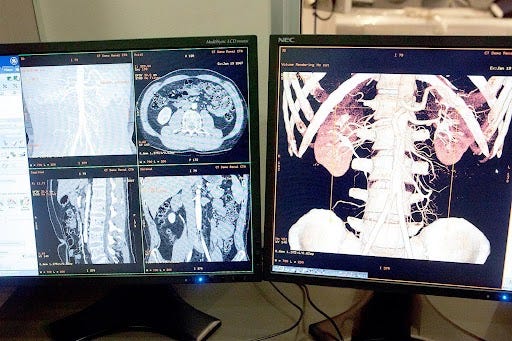
CT Coronary Angiography is a study investigating the arteries that supply the heart muscle. CT or CAT scan (Computerised Tomography) is a valuable diagnostic test that allows radiologists to see inside areas of the body, which cannot be seen using conventional X-rays.
Overview
This imaging method produces a series of pictures that are reconstructed by a computer into cross-sectional views. Significant technological advancements in recent years have greatly refined treatment courses. Medical Imaging Australia utilises the most advanced CT scanners available. Our scanners adopt the latest software to ensure the lowest radiation dose possible.
Coronary CT angiography involves an injection of X-ray dye and requires ECG leads to be connected to the chest. The CT scanner is utilised to image the heart and assess the status of coronary artery disease.
Preparing for a Coronary CT angiography
Please bring your referral (letter from your practitioner) and your Medicare and/or Pension Healthcare card with you to your appointment. It is important to bring all previous imaging relating to the region being scanned.
You will be asked to fast for three hours (drinking water is encouraged). Smoking is to be avoided for 12 hours prior to being scanned.
Stimulants, such as caffeine, should be avoided for 24 hours prior to the examination. Please cease Viagra or any similar medication in the 24 hours prior to your examination. Cease all blood pressure medications for the day of the examination. Continue all other medication as normal.
If available we ask that you bring in a copy of your latest blood test results, from within the last 12 months.
Beta blockers may be required to reduce the heart rate for the scanner. These may be prescribed by your referring doctor or administered prior to the examination if required. We ask that you bring a driver with you if this is the case.
You will be asked to sign a consent form, complete a medical history questionnaire and change into a gown.
Scanning
The radiographer will bring you into the CT room where you will be asked to lie down on the table.
The ECG will be connected to your chest to monitor your heart rate and a cannula is inserted into a vein for the administration of contrast. A dose of Nitrolingual spray under the tongue is given to dilate the arteries for accurate assessment. This spray is sometimes associated with a slight headache.
The radiographer is in full view and communication with you and the scanner does not touch you, nor do you feel the X-rays. There will be a slight buzzing sound and the table will move during the scan.
The contrast is administered halfway through the Coronary CT Angiogram. It is normal to experience a warm flush over the body, a metallic taste in the mouth and a warm sensation in the bladder. These sensations are normal and cease after a couple of minutes.
It is important that you lie very still and you will be asked to hold your breath as the images are acquired.
The procedure takes up to an hour to perform depending on your resting heart rate on arrival. You have no restrictions after having a CT scan and can go about your normal activities. To help eliminate the contrast medium from your body, drink plenty of fluids after the scan.
Results
The examination of the coronary arteries involves a detailed workup of the data obtained from the scan. This can take some time and hence the results may not be available on the day of examination. Any urgent situations encountered will be reported to your referring doctor on the day of examination.
Medical Imaging Australia strongly advises that you return to your practitioner, in order for your doctor to discuss your radiology report with you.
We understand that some patients are anxious about having tests performed. If you do have any questions or concerns, please do not hesitate to ask our staff.
FAQs
Can I continue my medication before a Coronary CT Angiogram?
If you are diabetic and take Metformin (also known as Glucophage, Diabex or Diaformin) you may be required to stop taking Metformin on the day of your CT and to have recent blood test (renal function) results with you. All other medications should be continued, especially beta blockers.
Why do I need to take beta blockers?
It is essential that your heart rate is between 60–65 beats per minute (bpm) to ensure the highest quality images with the lowest possible radiation dose.
What is the radiation dose for a Coronary CT Angiogram?
We follow the ALARA (as low as reasonably achievable) principle in regards to radiation dose. Our CT scanner uses the latest software to ensure the lowest radiation dose possible and our highly trained radiographers tailor the test to each individual patient.
How long will the Coronary CT Angiogram take?
The procedure can take up to an hour to perform depending on your resting heart rate on arrival. The scan itself takes 10–15 minutes. Please inquire when you make your appointment.
Can I eat and drive after a Coronary CT Angiogram?
You have no restrictions after having a CT scan and can go about your normal activities unless you have had beta blockers. To help eliminate the contrast medium from your body, drink plenty of fluids after the scan.
Do I have to take my clothes off for my Coronary CT Angiogram?
You may be requested to change into a gown.
Will the radiographer performing my scan, be able to tell me the results?
It is the radiographer’s duty to perform the test and ensure the images are clear for the radiologist (specialist) to interpret them.
